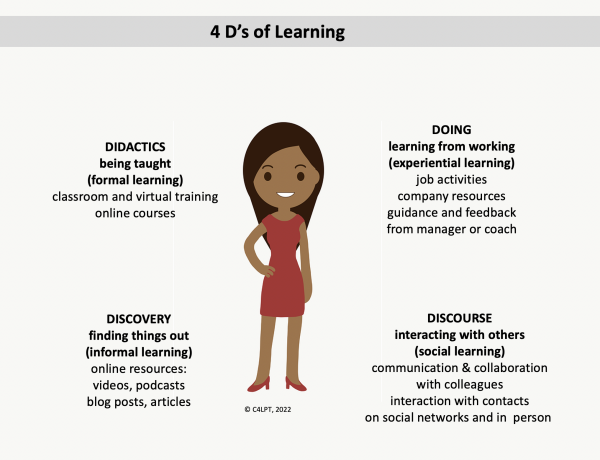This is a page of the first FREE section of MWL 2023.
Back: INTRODUCTION TO MODERN WORKPLACE LEARNING
 What is workplace learning?
What is workplace learning?
Let’s start by asking the question: what is learning? The dictionary definition is …
“the acquisition of knowledge or skills through study, experience, or being taught”
For many people, however it is the “being taught” aspect that they focus on – for that is how they have been conditioned to think they learn – having spent many years of their life in a classroom with a teacher. So it is inevitable that organizations focus on training as the main way to enable people’s learning in the workplace, since this approach has evolved from the education system. And that, too, is how many managers believe their people learn at work – by undertaking training. Hence, they see the Training Department as having total responsibility for workplace learning. In other words, if they have a perceived learning problem, they generally go straight to the Training Department to ask them to create, deliver and manage the training process for them.
Training is (mostly) a highly directed approach to learning; it involves telling people what, how and when to learn – and making sure they do it by tracking their activity to monitor learning outcomes. Although we have seen an evolution in the way that training is delivered in the workplace (primarily through the use of technology), it is still, essentially, about managing that same training process. Training Departments started by providing classroom training, where people were taken away from their day job in order to train them in scheduled events – in a separate training room. And, although this approach still continues in many organizations today, others have automated the process through online courses (aka e-learning) so that individuals no longer need to travel to training but can take online courses at their desktops.
But workplace learning is much more than just participating in a series of training events (in the classroom or online) or self-study, but continuously learning in a number of diverse – yet interconnected – ways. What are they?
4 D’s of Learning
For the last 14 years I have been carrying out a tools for learning survey, and this has revealed not just the most popular tools for learning, but also some interesting features about how and why people learn today, in particular it is clear that people learn in 4 main ways that I call the 4 D’s of Learning.
- They learn through DISCOVERY – that is by finding things out themselves (mostly on the Web) through searching or serendipitous browsing. We might also refer to this as Informal (or Personal) learning
- They learn through DISCOURSE – that is by interacting with others (whether it be in their professional social networks (like Twitter or LinkedIn) or with their work colleagues. We can refer to that as Social learning.
- They learn from DOING the day job and from their everyday work experiences. We might refer to that as Experiential learning.
- They learn through DIDACTICS – being taught or trained – what we usually refer to as Formal Learning.
This graphic show how the 4 D’s of Learning applies to how individuals learn at work – and some of the activities associated with each of them.

So, does an individual learn in equal measure from each of the 4 D’s of Learning, and if not where does most learning take place?
Next: How much do you learn from the 4 D’s of Learning?
Last updated: September 11, 2023 at 11:08 am